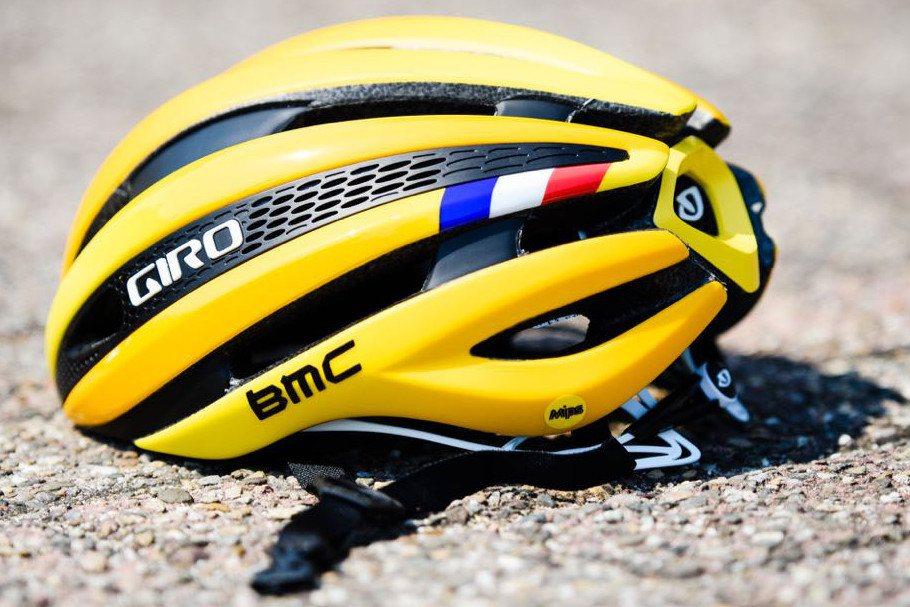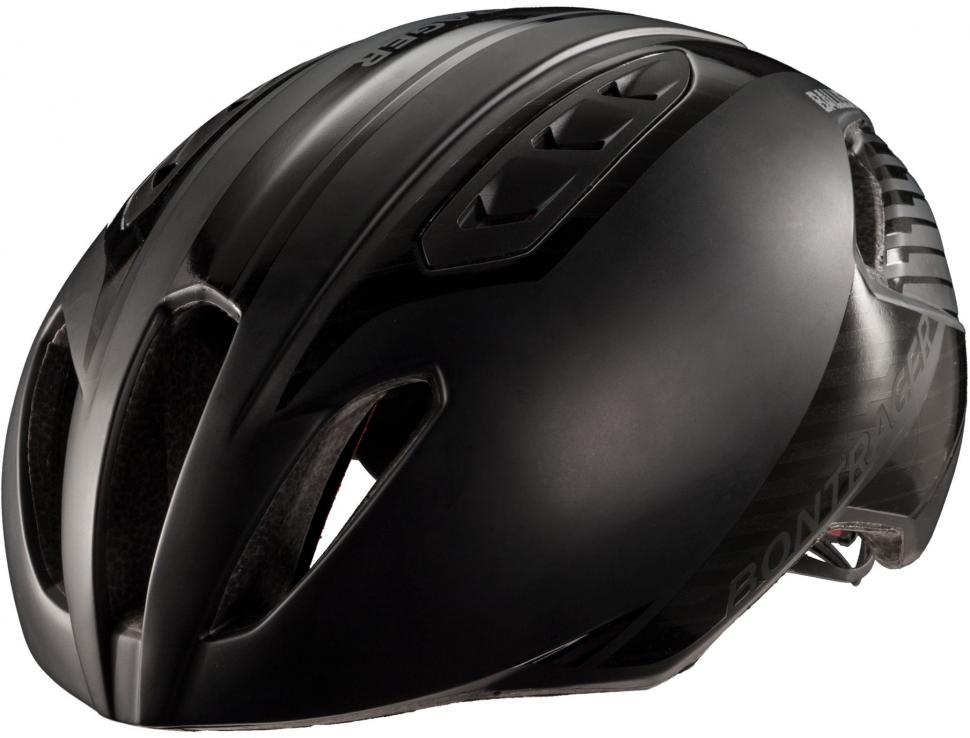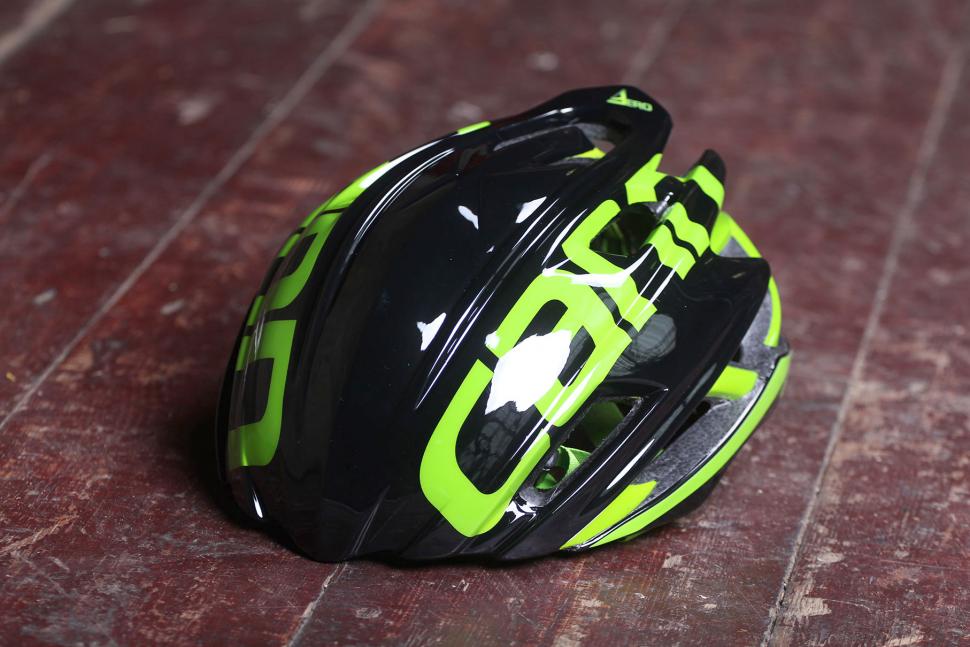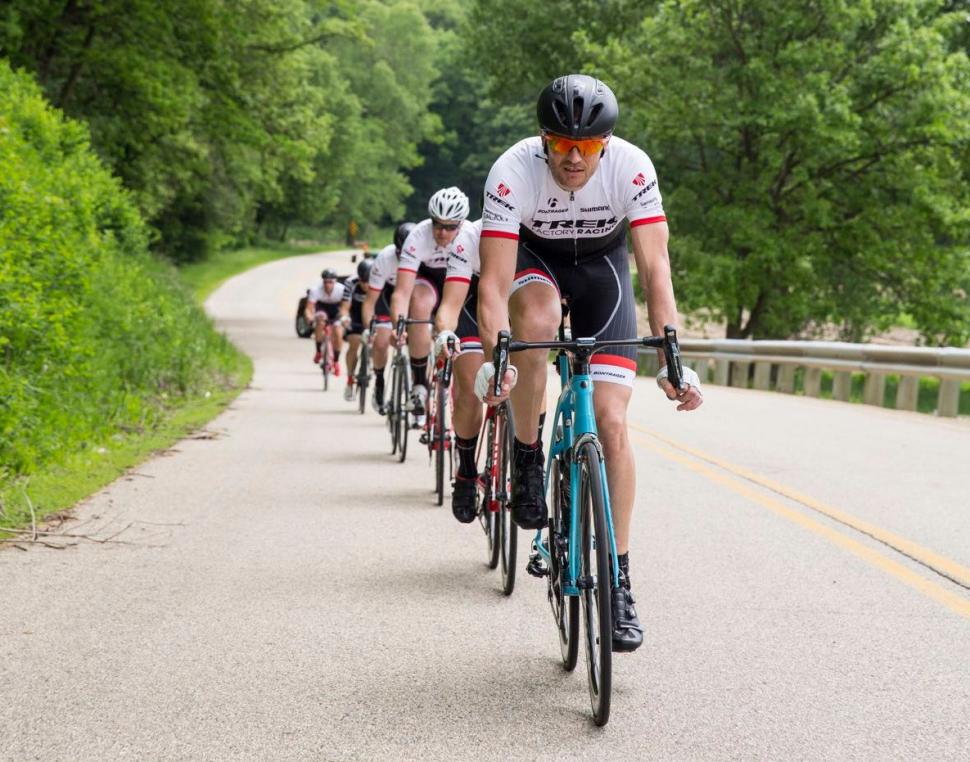- News
- Reviews
- Bikes
- Accessories
- Accessories - misc
- Computer mounts
- Bags
- Bar ends
- Bike bags & cases
- Bottle cages
- Bottles
- Cameras
- Car racks
- Child seats
- Computers
- Glasses
- GPS units
- Helmets
- Lights - front
- Lights - rear
- Lights - sets
- Locks
- Mirrors
- Mudguards
- Racks
- Pumps & CO2 inflators
- Puncture kits
- Reflectives
- Smart watches
- Stands and racks
- Trailers
- Clothing
- Components
- Bar tape & grips
- Bottom brackets
- Brake & gear cables
- Brake & STI levers
- Brake pads & spares
- Brakes
- Cassettes & freewheels
- Chains
- Chainsets & chainrings
- Derailleurs - front
- Derailleurs - rear
- Forks
- Gear levers & shifters
- Groupsets
- Handlebars & extensions
- Headsets
- Hubs
- Inner tubes
- Pedals
- Quick releases & skewers
- Saddles
- Seatposts
- Stems
- Wheels
- Tyres
- Health, fitness and nutrition
- Tools and workshop
- Miscellaneous
- Buyers Guides
- Features
- Forum
- Recommends
- Podcast
feature
 Trek Madone 2016 action - 36
Trek Madone 2016 action - 36Should you buy an aero road helmet? How much faster could you be?
Is it worth spending your hard-earned cash on an aero road helmet? We're going to check out everything that might influence your decision.
It’s all about the aggregation of marginal gains in cycling these days. You know the theory: make a small gain in everything you do and all those small gains could add up to become a winning margin.
But just how marginal is the gain you can get by swapping from a standard bike helmet to an aero road helmet?
The claims
Brands often make claims about the amount of time you’ll save by switching to their aero helmet.
Smith, for example, says that its Overtake helmet will save you about 25 seconds compared to a non-aero Giro Aeon over 40km (25 miles) at 40km/h (25mph) (Smith presumably means that a rider wearing the Giro Aeon would be going slightly slower than 40km/h at the same power output as an identical rider in an Overtake doing 40km/h).
Louis Garneau, on the other hand, released a paper when it launched its Course helmet in which it said that if a 70kg rider on a 9.1kg bike covered 40km in 53:20mins wearing a regular road helmet (stick with us!), the same rider would cover the distance in 51:22mins in an (unnamed) aero road helmet (presumably at the same power output), and in 50:40mins in the Louis Garneau Course.
In other words, according to Louis Garneau, swapping from a regular road helmet to the Course would save that rider 2:40mins in that scenario. That’s a huge chunk of time!
Specialized has what it calls its Win Tunnel – the company’s own wind tunnel at its California HQ. You might have seen its short videos that cover things like whether having a beard or shaved arms has an aero effect.
Specialized compared the performance of its Prevail standard road helmet, Evade aero road helmet (below) and S-Works TT helmet in the Win Tunnel and concluded that switching from the Prevail to the Evade would save you 40 seconds over 40km (25 miles).
Switching from the Evade to the S-Works TT helmet would save you another 20secs, but you’re not going to be using one of those for standard road riding/racing.
This testing was done on a time trial bike. The results would probably have been a little different on a road bike. In its sales literature, Specialized actually claims that the Evade would save you 46secs over 40km compared to a standard road helmet.
At what speed? Watch this video to find our why Specialized believes that the time will be more or less the same whatever the rider’s speed.
Specialized also says that a pro putting out 1,000 watts in a 200m sprint while wearing the Evade will finish 2.6m ahead of a rider in a Prevail putting out the same power.
The cynical among you might think that Specialized has an interest in exaggerating the aero performance of the Evade, but the S-Works Prevail and the S-Works Evade cost exactly the same – £159.99 – so there’s probably no benefit in the brand promoting one over the other.
And in the real world
Our man Dave Atkinson took the Giant Rivet aero helmet to road.cc’s local cycling circuit in order to find out whether wearing it would add speed compared to using a standard road helmet.
Over to Dave:
“This is a graph of my laps of Odd Down circuit wearing the Giant Rivet and a standard helmet for comparison, a Scott ARX Plus. I was using a set of Garmin Vector 2 pedals to measure my power, and the power spread is from an easy 150W average for the 1.5km lap up to about 270W average, which for me is going pretty hard. For reference, that's a fastest lap of 2:22, which is just under 4th cat race pace (2:18 on Saturday, when conditions were similar).

The graph shows power (watts) on the X (horizontal) axis and km/h on the Y (vertical) axis.
“What do the numbers say? Well, the trend line for the Rivet is above the trend line for the Scott, and depending on where you measure the offset you're looking at just under or just over 10W of difference. Put another way, 2-3 seconds a lap.
“It's not a rigorously scientific test and there are always going to be other variables at play in an outdoor environment, but it does suggest there's a measurable difference in the real world. Every little helps, right?"
Ventilation
Many aero helmets in the past have lacked ventilation. Manufacturers have made the shell smooth in order to minimise drag, keeping air out in the process. The result is that you end up uncomfortable.
When Ash reviewed the BBB Tithon, for example, he said that the ventilation wasn't spectacular, and Dave said that Bolle's The One helmet was too hot when all the vents are covered (it's adjustable).
However, many of the latest generation aero road helmets come with good venting. The Giro Synthe (above), for example, the Kask Protone, and the Louis Garneau Course all feel very similar to standard road helmets in terms of the amount of air that gets to your head.
When designing its new Ballista aero road helmet, Bontrager says that it created a thermal head form to evaluate the thermal efficiency of different helmets. The head form was covered with 36 thermal couples to determine the cooling properties of various designs and allow Bontrager to shape and position the vents most effectively.
As a result, the Ballista ended up with three vents in the front-centre, shaped to draw in air. Internal recessed channels are intended to manage airflow through the helmet and over the head, and exit ports at the back are designed to allow the air to escape easily so as not to increase drag.
Despite looking like it lacks ventilation, the Ballista feels cool in use, not too dissimilar to a normal road helmet.
Another option is to go with the Bell Star Pro which has a slider (above) in the top that allows you to open the vents for more cooling, and close them for improved aerodynamics.
Lazer takes a different approach with the Z1 helmet that we've reviewed here on road.cc (and others in the range). The Belgian brand allows you to use an Aeroshell (above) that can be either left off or added depending on whether you're prioritising cooling or aerodynamics (or protection from the weather conditions) on any given ride.
Kask's Infinity is similar in that you get easy ventilation adjustment via a central sliding panel. It's easy to slide the cover back and forth with one hand on the move, though there is no small lever as there is on the Bell helmet.
Cannondale does something similar with its Cypher Aero.
As a rule, aero road helmets are a little warmer than standard helmets. If you suffer with a hot head when riding or if it's a very hot day you might want to steer clear, but you’ll probably find a lot of the aero road helmets out there these days are comfortable in most conditions.
Weight
Here’s a quick roundup of the weights of the aero road helmets we’ve reviewed on road.cc (these are weights according to our scales rather than manufacturers' claimed weights).
| Helmet | Typical price | Weight |
|---|---|---|
| Limar Air Speed Road | £143.50 | 259g |
| Spiuk Korben | £66.99 | 257g |
| Bontrager XXX WaveCel | £198.99 | 361g |
| Lazer Bullet 2.0 | £169.95 | 359g |
| Abus AirBreaker | £165.94 | 214g |
| Kali Tava Flow | £193.59 | 272g |
| Bell Z20 Aero MIPS | £110.99 | 279g |
| Sweet Protection Falconer MIPS | £168.95-£200.47 | 291g |
| Specialized S-Works Evade II | £230.00 | 254g |
| HJC Furion 2.0 | ~£160.00 | 217g |
| MET Trenta 3K Carbon | £148.49 | 220g |
| Giro Vanquish MIPS | £135.00 | 367g |
| Abus GameChanger | £119.00 | 272g |
| Bontrager Velocis MIPS | £129.00 | 279g |
| Uvex EDAero | £118.55 | 318g |
| Met Manta | £114.99 | 215g |
| Met Strale | £60.00-£79.99 | 241g |
| Bontrager Ballista | £129.99 | 266g |
| Giro Synthe | £89.99 - £188.99 | 223g |
| Kask Protone | £99.00-£149.00 | 250g |
| Bell Star Pro | £178.49 | 300g |
| Spiuk Obuss | ~£110.00 | 307g |
| BBB Tithon | £62.99 | 280g |
| Bolle The One | £82.94-£155.99 | 340g |
| Kask Infinity | £109.00 | 265g |
| Giant Rivet | £60.00 | 299g |
| Specialized Airnet | £125.00 | 288g |
| Ekoi Corsa Light + shell | £57.61 | 216g |
| Scott Cadence Plus Mips | £184.97 | 346g |
| Smith Overtake Mips | £69.99 - £119.99 | 284g |
Giant claims a weight of under 250g for the new Pursuit aero helmet that we first saw at the Tour de France.
Aero road helmets do tend to be a little heavier than standard helmets of a similar price, but not by much and there are exceptions.
Price
Aero road helmets haven’t tended to be cheap in the past. The Kask Infinity is £220, for example, the Giro Synthe is £199.99 and, as mentioned above, Specialized’s S-Works Evade II is £240.
However, there are less expensive options out there these days. The Bontrager Ballista is cheaper than most at £129.99, the Spiuk Obuss is £99.95, and the BBB Tithon is £79.95.
Safety
Aero road helmets are made to meet the same safety standards as standard helmets .
So, should I buy an aero helmet?
Most aero road helmets are a little heavier and a little less vented than standard helmets, and they tend to be a little more expensive.
On the flipside, you’ll to get a small reduction in drag. It’s a marginal gain but it might just make an important difference if you intend to go off the front and try your luck in a race.
Check out all of our helmet reviews here. For reviews on individual aero helmets, scroll up to the Weight section above and click on each model name.
Mat has been in cycling media since 1996, on titles including BikeRadar, Total Bike, Total Mountain Bike, What Mountain Bike and Mountain Biking UK, and he has been editor of 220 Triathlon and Cycling Plus. Mat has been road.cc technical editor for over a decade, testing bikes, fettling the latest kit, and trying out the most up-to-the-minute clothing. He has won his category in Ironman UK 70.3 and finished on the podium in both marathons he has run. Mat is a Cambridge graduate who did a post-grad in magazine journalism, and he is a winner of the Cycling Media Award for Specialist Online Writer. Now over 50, he's riding road and gravel bikes most days for fun and fitness rather than training for competitions.
Latest Comments
- chrisonabike 41 min 25 sec ago
I'd agree there are a lot people who want no change whatsoever (or rather just don't think about change, busy getting on with life). Until...
- David9694 1 hour 43 min ago
I like how drivers make the case for making monitoring covert, not overt.
- andystow 1 hour 55 min ago
She seemed a bit upset about a minor misjudgement that could have killed someone and is going to cause months of stress and inconvenience.
- Backladder 2 hours 58 sec ago
No we don't agree, personally I would take primary, even if only for a short period although I can understand why some riders might not want to...
- brooksby 2 hours 22 min ago
And which looks very like the bag produced by indy bag manufacturer Wizard Works…...
- HoarseMann 2 hours 33 min ago
If it was a 'no vehicles' sign (all white circle centre), it would mean cyclists could ride in the hours that HGVs and disabled drivers are allowed...
- stonojnr 4 hours 3 min ago
The bit at the start and end looks like a cycle lane, but the bit they drive on looks just like a patched filter lane for traffic lights.
- JOHN5880 4 hours 4 min ago
Hey, you 4 execs helped run a company into the ground and have no jobs anymore... Come work for us because you have great experience in the...
- Oakhambike 4 hours 48 min ago
£11.5k for a bike weighing over 8kg that's 2 fingers to customers let alone UCI
- Dnnnnnn 5 hours 4 min ago
I'm going to show my bike a picture of this shed and tell it, "If you don't behave..."













Add new comment
54 comments
I'm guessing the Giant Alpecin helmet has the bonus of also keeping your scalp in good condition?
These new fangled aero jobbies are just a marketing ploy. You will now just have to buy some super duper new disc brakes in order to bring you to an over the bars stop due to the vast increase in speed that new helmet achieves !
How about some aero panniers to go with this new setup. "End to end record tumbles in aero speed frenzy" !
Disagree in the most part. Unlike brakes, wheels, and bike design, Helmets are lifed in use and this comes down to what happens when it's time for a new one. Granted, some people can afford the new "thing" but anecdotal evidence suggest a lot of people can't be that wrong.
I am not rich enough to warrant changing a perfectly good non-aero helmet for aero, but I will make a change to aero when I need a new one (after this season I guess). In the marginal gains arms race, this is a pretty good step on the balance of probabilities.
It's a good article, and makes those who insist on deep rims, and aero bike trickery ask themselves some searching cost benefit questions.
If your goal is to gain some places on Strava then buying an aero helmet is a stupid way to do it. A much more aerodynamically efficient solution - and £200+ cheaper to boot is:
- Shave your head billiard smooth, don't wear a helmet.
If you don't want to do that, wear a smooth fabric cap tight over your head.
As a bonus, if you suffer from "hot head", these will help cool your head better than _any_ amount of ventilation in a helmet.
The *only* "helmets" that beat a smooth head are the pure aerodynamic ones - the ones with out any polystyrene, without any "safety" rationale, that do not increase the frontal area of the head, that exist solely to improve aerodynamic flow. Anyone recommending any kind of large "aero" safety helmet for speed gains in a situation that doesn't require a safety helmet is an idiot (at least wrt aerodynamics).
If you're wondering whether or not you should buy an 'aero' helmet for marginal gains in aerodynamic efficiency, it's more than likely you don't need it.
Thought this might help
aero.png
That was my thinking too - bought a aero helmet in the sales as my winter helmet. First time I wore it I got ice cream head from the cold wind whistling through ! So my thinking was pretty flawed. It seems as ventilated as my normal road helmet. That I was meant to switch to in Summer but somehow never got round to.
The lack of vents will at least keep the snow off though - but don't bank on it being noticeably warmer than normal helmets.
In deepest coldest winter I go two buffs - one under the hat and over the ears. The other round the neck and up over the jaw if needs be.
I would suggest that one of the real issues with "real world testing" is that it isn't enough of a controlled enviroment to justify the results with any statistical significance.
Computational Fluid Dynamics would yeild results which could more accurately compare the difference in helmets; however, displaying results in terms of Drag Co-efficient means SFA to us when we're out on the road.
So I guess it puts reporters in a lose-lose situation, either do a statistically insignificant test which produces a fancy curve in terms of Watts and M/Kph (meaningful to us as cyclists) or do a controlled test which produces statistically significant results in terms of Drag Co-efficient (not very useful unless you fancy using the Navier-Stokes and Drag Co-efficient equations to derive forces and therefore power etc).
This is purely based on my experiences - I don't have a wind tunnel ! As someone who is interested (/obsessed) with the hour record, I spend a lot of time riding round my local velodrome at threshold pace measuring everything I can. There are 2 main helmets I use; a Giro Foray (cheap 'normal' helmet) and a Lazer Wasp Air (aero helmet) - from the various data that I collect there is a difference between them - sadly even at an hour long run at threshold the difference is quite small. I'll take it though - changing from spoked aluminium Mavic Ellipse clincher front wheel to a Corima 3 Spoke tubular had a similar effect and that cost about 4-5x as much as both the hemets put together!
As for the comment earlier:
" I don't believe that the average speed of a typical amateur either riding solo or on a club ride has changed much in the last two or three decades despite all the technological (aero) advances. Has it?"
I think it has. It used to be pretty impressive to do a 40km TT im under an hour. Now that we have TT bikes and all the rest of the equipment (in particular skinsuits) I'd argue that 40km an hour is fairly acheiveable for the average club rider. I'd say a modern equivalent now would be doing 40km in 55minutes or maybe even less, 50minutes perhaps.
dafyddp -
Richard1982 -Can you share some data? There was a recent article (http://www.cyclist.co.uk/in-depth/534/how-much-time-can-aero-kit-save) where someone rode round Hillingdon at 300W and looked at the difference aero bars, deep sections, helmets, skinsuit etc. made.
I was surprised the skinsuit made little difference.
Can you share some more of your data?
In a race and or time trial, yes it has. In 1988 I won our centre (region) TT champs on a standard road bike in 57.17 (40km) at 20 yrs of age. It's not a flat course. At the time that was within 40 secs of the course record. The record and winning time has continued to drop until it is now just over 51 minutes. It hasn't dropped to one outstanding rider, but has dropped over the course of the years to various riders. Last night I did a club TTT 12.5 miles Our team won in 26.30. One of the guys I was riding with was full TT bike and aero kit (skin suit, aero helmet, boot covers, disc wheel). I was on a standard (supersix evo) road bike with no aero gear. As luck would have it, we are both the same height and our total bike and rider weight was within 2kg. We were goin the pace of the slowest rider so were operating less than full out (i.e. we weren't going faster on the laps I took than the laps the other rider took.) In full TT kit, his average (normalised) power output as measured on his stages power meter was 306W, My normalised power as measured powertap G3 hub was 343 watts.
Having said that, you might not consider me an average amateur (Cat 2 racer) and you might not argue these results reflect riding solo or a club ride, but in short, average speeds in the pro peleton have climbed over the last 3 decades, and in amateur racing. Nowadays 25mph for 50 yr old masters racers on a 60 mile hilly course is pretty normal (my race last weekend) whereas 30 years ago that was the average speed of the open racers on the same course. The open racers this weekend averaged 27 mph.
In my experience, yes. The average speed of amateurs has climbed, and largely I think due to aero and equipment improvements.
I go with this flowchart.
Should I buy a lighter / faster / more aerodynamic bike / wheels / helmet / aerosuit?
Do I really want it? Yes / No
Can I afford it? Yes / No
No other consideration is necessary.
I use a brilliant Casco
https://www.sigmasport.co.uk/item/Casco/SPEEDairo-Helmet-with-Visor/2KJY
NOT for aerodynamics though. I think it is much, much safer. The view you get when glancing over your shoulders is SO much better than using sunglasses when you're mostly looking 'around' the glasses' stems and frame. If I have to ride in a sunglasses/ordinary helmet combo I get the heebijeezus from how little I see over my shoulder. You have to try it to believe me. Ditto for getting more flat backed without neck pain. Riding with others I always feel I am much lower and flatter than most.
Oh, and did I mention you can wear it with your regular prescription glasses underneath? For that alone I'm amazed they aren't more popular - how much are prescription inserts? And when you weigh up the price, factor in that you'll never need to buy/loose/leave behind/sit on and break any more expensive sunglasses.
Overheating isn't a problem. Did the Pyrenees in July in this helmet. TBH I think the important stuff to do with the airflow through a helmet happens at the back.
It looks a bit helicopter pilot but who cares, all the other helmets on this page look rubbish too. And combined with sunglasses, yuck. I'm surprised there isn't a Rule against it.
Science doesn't have much room for opinion, it's usually just the difference between those people who understand the data and those who don't.
[/quote]
ROFLMAO
Let me introduce you to a little tome called "This thing called Science" by a Mr Chalmers. You may find it enlightening.
Science is almost exclusively opinion. Mathematics is not. Statistics largely is.
"Matter is divided up into atoms, which are indivisible" JJ Thompson. That was his opinion based on sound evidence until he measured the mass of cathode ray (particles) at less than .05% the mass of a hydrogen atom.
Currently we know of 19 sub atomic particles.
All data is interpreted which is then presented as an opinion.
Any scientist who says they have irrefutable evidence, is not a scientist. No scientist knows anything for sure. They just have their opinion based on the available data.
I bought a Bontrager Ballista as my old helmet was pretty shabby.
I chose the Ballista because;
90% - It looks cool
9% - Great deal from my LBS
1% - It possibly might have some marginal gain for my 18+ mph average speed rides
"Should you buy an aero helmet?"
No. Anyone who really needs an aero helmet will receive one from their sponsors, or at least get 50% off. The male jewelry argument is legitimate, but virtually no one owns up to that reality.
I only wear an aero helmet (POC Octal Aero) to keep my bald head warm in the winter. Training makes you faster.
My Giro Air Attack Shield...
a) Keeps my head dryer in the rain.
b) Keeps my head warm on a cold day or fast descent.
c) Keeps bugs out.
d) Eliminates need for glasses.
e) Looks OK.
...
z) Gives me aero advantage.
One important point with ventilation is the holes placed at the front so when your head is up looking forward you get ventilation once you tuck your head down(chewing the stem) the smooth flat area comes into effect giving the higher aerodynamics which suits most people trying to sprint.
some people who cannot get the head below their shoulders will get less of a saving as the head and helmet will still be creating a large frontal drag.
I'm looking at buying a giro Vanquish and wondering if they are worth the money. I've read some great reviews. However, I want to make sure the helmet would be worth the money.
[/quote]
ROFLMAO
Let me introduce you to a little tome called "This thing called Science" by a Mr Chalmers. You may find it enlightening.
Science is almost exclusively opinion. Mathematics is not. Statistics largely is.
[/quote]
You misunderstand how science works. Unlike religion, science makes no statements of 'truth'. Unlike opinions, there is little room for subjectivity in science. What there is, is evolution of the scientific consensus, propelled by newer experimental results and by better theories to interpret them.
By the way, newer scientific theories generally do not 'disprove' the older ones but rather extend them to a higher degree of generality, e.g. Einstein's relativity did not prove Newton was 'wrong', only that newtonian mechanics is a special case valid at lower speeds.
If you want to do your own scientific / semi scientific / pseudo scientific / blind faith / prejudice confirming research, but lack the funding for your efforts, there are cheaper aero helmets available. My son has a Carnac, bought in a flash sale for £14, and likes it. He does suggest that it's warmer than his BTwin conventional helmet and it's certainly heavier than the very light but otherwise vile Tesco helmet he uses for hill climbs. Does it help him slice through the air or just give it a nasty bruise? Who knows, but he thinks it helps and that placebo may be useful.
Clearly those are just his experiences / data from his repeatable controlled experiments and I share them to enrage / help, depending on your biases.
Right, I'm just off to Primark in the Dacia to see if they have any seconds.
Out of curiosity how much difference 9if any) between a bare head compared to aero helmets? On the flip side does not wearing a helmet benefit performance, particularly re head temperature which must be boil in a bag during the warmer months with(a helmet) and maybe even comfort factor such as rubbing on head/chin, more sweat on face, neck strain etc over longer efforts that could be detrimental?
I read some Bike Radar chat years ago but there was no definitive answer.
I don't care about aero (though I'm reading this), but I'd like to know if any of these helmets make less wind noise during cycling. My Giro Aeron is just unbelievably noisy above 20kmh, I can't hear a thing. I'd love a helmet that made less wind noise!
Pages